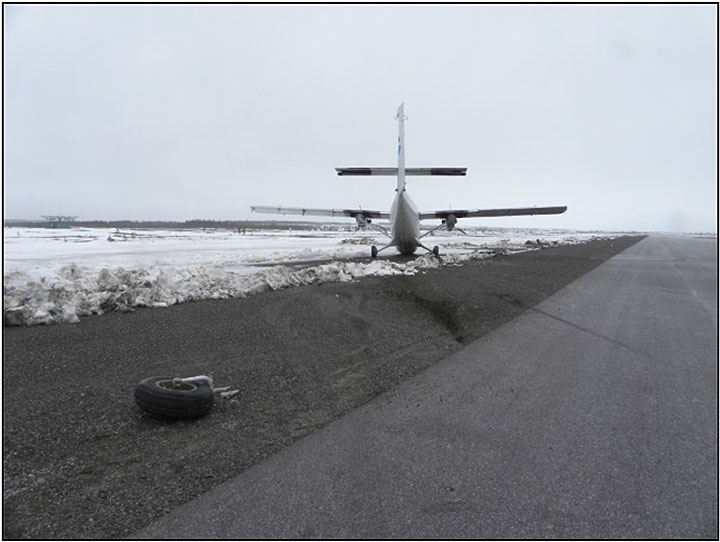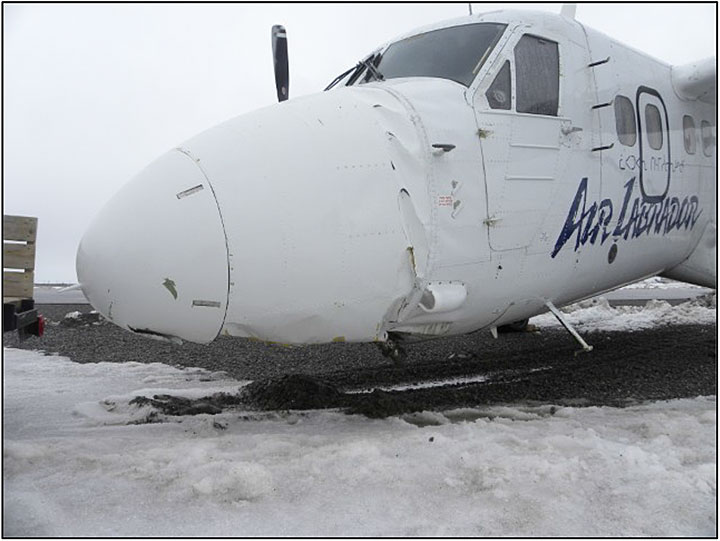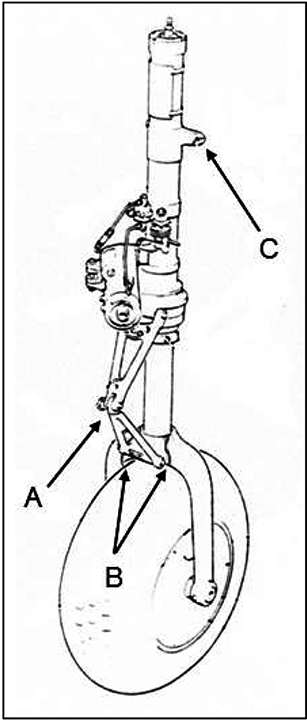Nosewheel failure on landing
Air Labrador Limited
de Havilland DHC-6-300, C-FOPN
St. Anthony, Newfoundland and Labrador
The Transportation Safety Board of Canada (TSB) investigated this occurrence for the purpose of advancing transportation safety. It is not the function of the Board to assign fault or determine civil or criminal liability. This report is not created for use in the context of legal, disciplinary or other proceedings. See Ownership and use of content. Masculine pronouns and position titles may be used to signify all genders to comply with the Canadian Transportation Accident Investigation and Safety Board Act (S.C. 1989, c. 3).
Summary
The de Havilland DHC-6-300 Twin Otter aircraft (registration C FOPN, serial number 291) was landing at St. Anthony Airport, Newfoundland and Labrador, with 2 crew members and 8 passengers on board. The aircraft first contacted the runway with the left tire, bounced, and became airborne before touching down hard on the nosewheel. The nose landing gear collapsed, and the aircraft skidded on its nose, coming to rest 96 feet off the north side of Runway 10. There were no injuries. The aircraft was substantially damaged. The 406-megahertz emergency locator transmitter did not activate. The accident occurred at 1253 Newfoundland and Labrador Daylight Time.
Factual information
History of the flight
At 1232,Footnote 1 the aircraft departed Mary's Harbour Airport, Newfoundland and Labrador, under visual flight rules (VFR) toward St. Anthony, Newfoundland and Labrador. The first officer was the pilot flying (PF), and the captain was the pilot not flying (PNF).
The crew obtained weather information from the St. Anthony automated weather observation sytem (AWOS), which reported winds 030° true (T) at 27 knots, gusting to 38 knots.
On approach to Runway 10, the landing checks were completed, and flaps were selected to 20°.
The captain and first officer (FO) discussed approach and landing considerations due to the strong crosswind.
It was decided that the FO would continue the approach. The captain offered guidance for maintaining the aircraft on the runway centreline.
Just prior to landing, the FO was experiencing difficulty with aircraft control. The captain asked if the FO wanted to transfer control. The FO agreed, and the transfer of control was completed less than 2 seconds before touchdown. The aircraft touched down on the left main wheel, bounced, and landed hard on the nosewheel. The nosewheel separated from the aircraft, and directional control was lost.
The aircraft yawed left, and the right wing tip momentarily contacted the runway surface. The aircraft slid on its nose for 488 feet, coming to rest off the north side of the runway, approximately 2000 feet from the runway threshold (Photo 1).
There were no injuries to either passengers or crew members.
Damage to aircraft
The nosewheel and a portion of the nose fork detached from the nose landing gear (NLG) strut, and the aircraft collapsed onto the NLG strut (Photo 2).
The lower end of the NLG strut was displaced aft, and the structural bulkhead where it is installed was deformed along with various airframe skins and structural components of the fuselage nose section and cockpit floor.
Both left and right main landing gear (MLG) leg attachment frames were gouged as a result of contact with the gear legs.
The right wing-tip fairing and outer aileron hinge bracket were abraded due to contact with the runway surface.
There was minor damage to the runway surface from the scraping of the nose oleo and the outboard aileron hinge.
Pilot information
The previous day, the crew departed Goose Bay, Newfoundland and Labrador, completed the day's flight duties, and spent the night away from the base. The day of the occurrence, the crew had conducted 8 flights before the occurrence flight, alternating PF and PNF duties.
Records indicate that the flight crew was certified and qualified for the flight in accordance with existing regulations. There is no indication that fatigue, incapacitation, or physiological factors affected the crew's performance.
| Captain | First officer | |
|---|---|---|
| Licence | Airline transport pilot licence—Aeroplane | Commercial pilot licence—Aeroplane |
| Medical certificate expiry date | 01 October 2013 | 01 April 2013 |
| Total flying hours | 4500 | 660 |
| Hours on type | 3500 (400 as pilot-in-command) | 450 |
| Hours last 90 days | 106 | 198 |
| Hours last 30 days | 43 | 81 |
| Hours off prior to work | 10 | 10 |
Aircraft information
The DHC-6 Twin Otter is a high-wing, unpressurized, twin-engine turboprop, short takeoff and landing utility aircraft with a fixed tricycle landing gear and a capacity of 19 passengers. It was designed and manufactured by de Havilland Canada. The occurrence aircraft was manufactured in 1970, and, at the time of the occurrence, had accumulated 16 808 hours total time since new.
Records ndicate that the aircraft was certified, equipped, and maintained in accordance with existing regulations and approved procedures, and that there were no known deficiencies before the occurrence flight.
The NLG assembly, along with the attached steering actuator, (Figure 1) were sent to the TSB Laboratory.
The initial NLG failure occurred when the lower torque link arm fractured below the attachment point to the upper torque link arm (Figure 1, A). Additional failures were noted at points B and C in Figure 1.
All fractures were due to overstress, and there were no pre-existing conditions that would have contributed to the failure of the NLG.
The DHC-6-300 aircraft flight manual (AFM) states:
With full flap (37.5°) crosswind landings have been demonstrated in a maximum crosswind component of 20 knots measured at 6 feet, which is equivalent to 27 knots at 50 feet. This was the maximum encountered during crosswind landing trials, and is not considered limiting. The preferred technique requires that the upwind wing be lowered during the approach with sufficient opposite rudder applied to align the aircraft with the runway. As airspeed decreases during the flare and rollout, both of these control applications must be increased.Footnote 2
The AFM does not indicate a demonstrated maximum crosswind component at other flap settings. The captain used the AWOS weather report to calculate that the maximum crosswind component was 32 knots at 90° to the runway.
Meteorological information
The St. Anthony AWOS-reported weather at 1230 was as follows: wind 030°T at 27 knots, gusting to 38 knots, visibility 9 statute miles (sm), ceiling broken at 900 feet above ground level (agl), overcast at 3200 feet agl, temperature 2°C, dew point 0°C, and altimeter 29.60 inches of mercury.
Aerodrome information
St. Anthony Airport (CYAY) has 1 asphalt runway surface within a control zone classified as Class E airspace. Runway 10/28 is 4000 feet long by 100 feet wide. Runway 10, which is oriented 099° magnetic (M), has a 0.5% downslope and is served by area navigation (RNAV) global navigation satellite system (GNSS) and very high-frequency omnidirectional range (VOR) non-precision approaches.
Runway 10 has centre row (AD) and runway identification lights (AS), as well as medium-intensity threshold and runway end lighting (TE ME). A precision approach path indicator (PAPI), suitable for aircraft with an eye-to-wheel height of up to 10 feet, is also located on the approach to Runway 10. These were all serviceable at the time of the occurrence.
Given the actual wind and the runway in use, the aircraft would have encountered a gusty 30-knot crosswind component on final approach.
Flight recorders
The aircraft was equipped with a Honeywell model SSCVR (part number 980-6020-001, serial number 1963) cockpit voice recorder (CVR). TSB personnel removed the CVR and it was sent to the TSB Laboratory with the data intact.
The aircraft was not equipped with a flight data recorder (FDR), nor was one required by regulation.
Company
Air Labrador Limited (Air Labrador) was established in 1948, and its head office is located in Goose Bay, Newfoundland and Labrador. The company provides scheduled cargo and charter flights as well as emergency medical flights. Its current fleet of aircraft includes 7 Twin Otters, 1 Cessna Caravan, 1 Beechcraft 1900D, and 1 King Air 100.
The company reviews resumes of applicants and interviews candidates who are sometimes hired directly from flight school. Twin Otter crew training is provided internally. Once a pilot has gained adequate experience, and an opportunity exists for progression, upgrade training to captain is offered. This training consists of 20 hours of technical ground training, 5 hours of supervised pilot-in-command training, and at least 20 hours of line indoctrination.
Flight crews do not receive crew resource management training, nor is it required by regulation.
Air Labrador safety managemen system
Air Labrador became a Canadian Aviation Regulations (CARs) Subpart 05 operator in 2003. In 2007, the implementation of a safety management system (SMS) began in order to meet Transport Canada requirements. Air Labrador completed phase 3 of 4, which included the development of an SMS manual. In the spring of 2009, the company ceased CARs Subpart 705 operations, and the SMS certification process was halted. Air Labrador currently maintains a CARs Subpart 704 operation and is therefore not required by regulation to have an SMS. However, Air Labrador still has a complete SMS manual. The company's practice was to refer new hires to the SMS manual for guidance purposes, yet only the incident reporting components of the manual were used. No SMS recurrent training is carried out, no formal safety meetings are held and there is no proactive hazard identification.
If an issue arises that requires a team review, it is conducted by the general manager, chief pilot, and company aviation safety officer. Operational incident reports are reviewed using a traditional approach to safety management. This approach relies primarily on regulatory compliance, as well as reacting to undesirable events by identifying the underlying causes and prescribing specific measures to prevent their recurrence. Any resulting corrective and preventative actions are documented on the company's SMS Hazard Investigation form.
Standard operating procedures
Captains are expected to use their judgement in providing flight training opportunities to junior first officers. Crews share pilot flying duties on a rotational basis, unless the captain determines otherwise.
The Air Labrador Twin Otter standard operating procedures (SOPs) do not state when the captain should permit the FO to act as pilot flying or when to relieve the FO from this role. The company expects each captain to use their discretion to determine if a FO is competent to carry out the flight.
The Air Labrador Twin Otter SOPs require that the PF carry out an approach briefing. This is to ensure the PNF is aware of the PF's intentions when conducting the approach and landing, and to identify any responsibilities for the PNF. No approach briefing was carried out on the occurrence flight.
TSB Laboratory reports
The following TSB Laboratory reports were completed:
- LP 0592013 - Examination of Nose Landing Gear Assembly
- LP 0622013 - CVR Download and Transcription
- LP 0632013 - Nonvolatile Memory Download
Analysis
The company SOPs did not indicate when a captain was to permit an FO to control the aircraft. Captains were expected to use their descretion to determine the competency of the FO for the existing flight conditions. No approach briefing was carried out on the occurrence flight.
When allowing the FO to fly in challenging conditions, captains must consider the risk associated with the FO continuing the flight. The aircraft captain must be prepared to take control of the aircraft in adequate time to ensure the safety of the flight.
The transfer of control occurred during the landing flare, with the approach flap setting at 20°. Once control of the aircraft was passed to the captain, there was insufficient time to position the aircraft for a successful landing because of the substantial crosswind. This resulted in a hard landing, leading to the nose gear collapse due to overstress failures.
Findings
Findings as to causes and contributing factors
- The captain permitted the first officer to continue with a challenging approach.
- Control of the aircraft was passed to the captain with insufficient time to position the aircraft for a successful landing.
- The aircraft landed hard, resulting in the collapse of the nose gear due to overstress failures.
Findings as to risk
- If a required briefing is not conducted, the crew members may not share a common plan for the approach and landing, and the transfer of control may not be completed in a timely manner, increasing the risk of a landing accident.
Safety action
Safety action taken
Air Labrador Limited
Air Labrador reviewed this event. The captain was temporarily downgraded to first officer until completion of supplementary training. The company Twin Otter standard operating procedures (SOPs) were amended to state that the captain will conduct all landings with crosswinds in excess of 10 knots. However, if the captain feels that the first officer (FO) is capable of performing the landing, then it will be at the captain's discretion to allow the FO to conduct the landing.
The Air Labrador Twin Otter SOPs now restrict all landings to crosswinds of 30 knots at 90°.
This report concludes the Transportation Safety Board's investigation into this occurrence. the Board authorized the release of this report on . It was officially released on .


